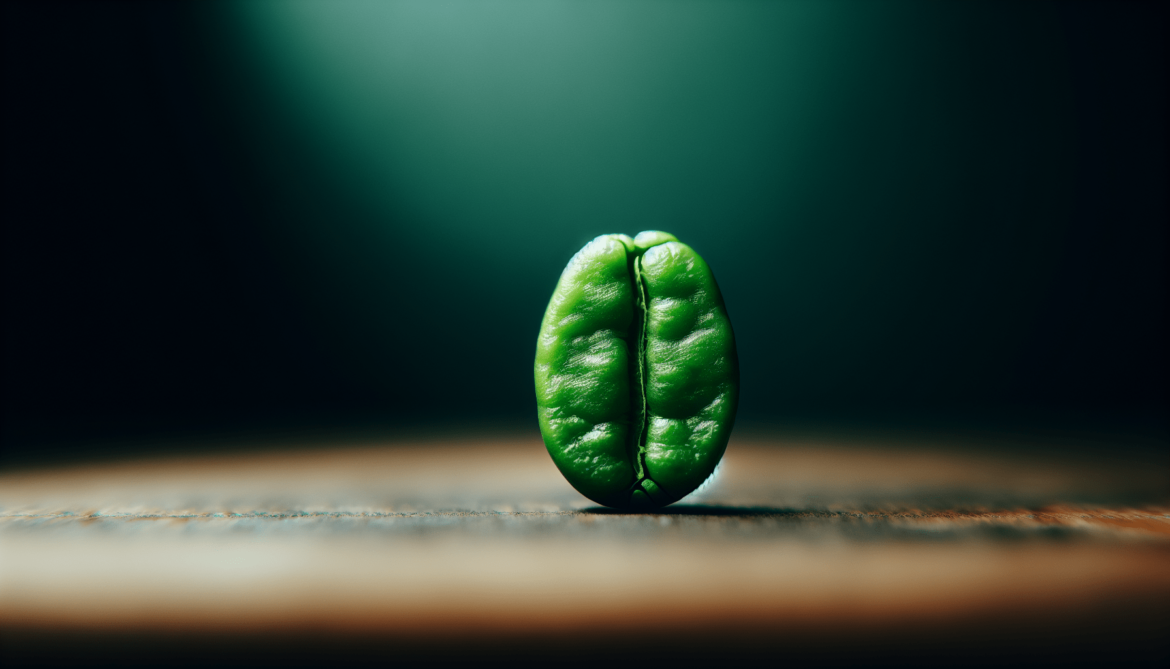Have you ever wondered about the journey your morning cup of coffee takes before it reaches your lips? In this article, we invite you to explore the captivating world of raw coffee beans. From their origins in lush coffee plantations to their meticulous harvesting and processing techniques, we will dive deep into the fascinating process that transforms these humble beans into a beloved caffeinated beverage. So grab a fresh brew, sit back, and prepare to embark on a journey through the hidden world of coffee beans.
Introduction to Raw Coffee Beans
Definition of raw coffee beans
Raw coffee beans, also known as green coffee beans, are seeds that are harvested from the Coffea plant before they undergo the roasting process. These beans are the unroasted form of coffee beans and possess a range of flavors and characteristics that are brought out through the roasting process.
Characteristics of raw coffee beans
Raw coffee beans are small, hard, and vary in color from green to yellow. They have a high moisture content and contain numerous compounds such as acids, lipids, and sugars that contribute to the unique flavors found in coffee. The specific characteristics of raw coffee beans will vary depending on the variety of coffee, growing conditions, and processing methods.
Types of Raw Coffee Beans
Arabica coffee beans
Arabica coffee beans are the most well-known and widely consumed type of coffee bean. They are generally regarded as having a more complex and nuanced flavor profile compared to other coffee beans. Arabica beans are known for their acidity, fragrance, and softer body. They are often grown at higher altitudes and require specific climate conditions to thrive.
Robusta coffee beans
Robusta coffee beans are another popular variety of coffee bean, especially in commercial blends. These beans have a higher caffeine content and are known for their bold and bitter flavor. Robusta beans are grown at lower altitudes and are more resistant to diseases and pests compared to Arabica beans. They contribute to a stronger and more robust flavor in coffee blends.
Other coffee bean varieties
In addition to Arabica and Robusta, there are several other less commonly known varieties of raw coffee beans. Examples include Excelsa, Liberica, and Maragogipe beans. These varieties often have unique flavor profiles and characteristics that can add complexity to coffee blends.
Processing Methods for Raw Coffee Beans
Washed process
The washed process, also known as the wet process, involves removing the outer cherry and pulp from the coffee beans before drying them. This method allows for more control over the fermentation process and results in a cleaner and brighter flavor profile. Washed coffee beans generally have a higher acidity level and showcase the intrinsic flavors of the coffee variety.
Natural process
The natural process, also known as the dry process, involves drying the coffee cherries with the beans still inside. This method allows the beans to absorb the sugars and flavors of the cherry as they dry, resulting in a fruitier and sweeter flavor profile. Natural processed coffee beans often have a lower acidity level and exhibit pronounced fruit notes.
Honey process
The honey process is a hybrid of the washed and natural processes. During this method, the outer skin of the cherry is removed, but some of the mucilage or ‘honey’ is left on the beans, which gives them a sticky texture. The beans are then dried. Honey processed coffee beans can exhibit a range of flavors, depending on the amount of honey left on the beans. They often have a medium acidity level and a smooth, syrupy body.
Semi-washed process
The semi-washed process, also known as pulped natural or semi-dry process, involves removing the outer skin and most of the pulp from the coffee beans before drying them. This method allows for some fermentation to occur, resulting in a unique flavor profile that combines elements of both the washed and natural processes. Semi-washed coffee beans often have a balanced acidity level and exhibit a pleasant sweetness.
Factors Affecting Raw Coffee Beans’ Quality
Altitude
The altitude at which coffee is grown plays a significant role in the quality of the raw coffee beans. Higher altitudes often result in slower maturation of the beans, allowing them to develop more complex flavors and enhanced acidity. Altitude also influences the density and size of the coffee beans, which can affect the brewing process and the overall taste profile.
Climate
The climate in which coffee is cultivated has a direct impact on the quality of the raw coffee beans. Ideal coffee-growing climates are characterized by moderate temperatures, consistent rainfall, and distinct seasons. These conditions allow for the proper development of flavors and sugars in the beans, contributing to a higher-quality end product.
Soil
The soil composition and fertility of the coffee-growing region influence the nutrients and minerals available to the coffee plants. Well-balanced soils with adequate organic matter support the growth of healthy coffee plants and contribute to the development of desirable flavor profiles. Different soil types can impart unique characteristics to raw coffee beans, resulting in distinct flavors.
Harvesting Techniques
The harvesting techniques employed by coffee farmers can greatly impact the quality of the raw coffee beans. Selective hand-picking, where only ripe cherries are harvested, ensures that only the highest quality beans make it into the batch. Machine harvesting, on the other hand, can lead to a mix of ripe and underripe cherries, which can affect the overall flavor and consistency of the coffee beans.
Growing Regions and Raw Coffee Beans
Latin America
Latin America is renowned for producing high-quality Arabica coffee beans. Countries such as Colombia, Brazil, Costa Rica, and Guatemala have ideal coffee-growing conditions, including elevated altitudes and fertile soils. Latin American coffee beans are often characterized by their bright acidity, delicate flavors, and balanced profiles.
Africa
Africa is known as the birthplace of coffee, and the region continues to produce some of the most sought-after coffee beans in the world. Countries like Ethiopia, Kenya, and Tanzania are renowned for their vibrant and fruity Arabica varieties. African coffee beans often exhibit complex flavor profiles with notes of citrus, berries, and floral undertones.
Asia
Asia, particularly countries like Indonesia, Vietnam, and India, produces a mix of Arabica and Robusta coffee beans. Asian coffee beans are known for their bold and earthy flavors, often with hints of spice and chocolate. These beans are commonly used in espresso blends and contribute to the richness and body of the final cup.
Pacific Islands
The Pacific Islands, including Hawaii, Papua New Guinea, and the Philippines, are known for their unique and specialty coffee varieties. These islands offer specific microclimates and volcanic soils that cultivate distinctive flavor profiles. Pacific Island coffee beans often have a smooth and delicate acidity, with flavors ranging from tropical fruit to floral notes.
Sourcing and Buying Raw Coffee Beans
Direct trade
Direct trade is a sourcing method that involves working directly with coffee producers and farmers, bypassing intermediaries. It allows for a more transparent and mutually beneficial relationship between the coffee buyer and the producer. Direct trade often ensures higher prices for farmers and provides buyers with traceability and access to unique coffee varieties.
Fair trade
Fair trade certifications ensure that coffee farmers receive fair wages and acceptable working conditions. By purchasing fair trade raw coffee beans, buyers support sustainable farming practices and promote social and environmental responsibility within the coffee industry. Fair trade coffee beans are often labeled with a certification symbol, making it easier for consumers to make ethical purchasing choices.
Certifications
Aside from fair trade certifications, there are various other certifications that coffee buyers can look for when sourcing raw coffee beans. Organic certifications guarantee that the coffee beans were grown without the use of synthetic fertilizers or pesticides. Rainforest Alliance and UTZ certifications focus on environmental and social sustainability within coffee production. These certifications provide ethical and quality assurances to buyers.
Roasting Raw Coffee Beans
The importance of roasting
Roasting is a crucial step in the coffee production process as it transforms raw coffee beans into the aromatic and flavorful beans used for brewing. During roasting, the green coffee beans undergo chemical changes that develop their unique flavors and aromas. The degree of roasting greatly influences the taste profile of the coffee, with different roast levels offering distinct characteristics.
Different roast levels
Coffee beans can be roasted to different levels, each resulting in a different flavor profile. Light roast beans are generally lighter in color and have a higher acidity, with more delicate and subtle flavors. Medium roast beans have a balanced acidity and offer a combination of vibrant flavors and a fuller body. Dark roast beans, on the other hand, exhibit deeper, smoky flavors and have a lower acidity level.
Tasting and Evaluating Raw Coffee Beans
Cupping process
Cupping is the professional method used to evaluate the flavors and qualities of raw coffee beans. It involves carefully observing and assessing the aroma, acidity, body, and overall taste profile of the brewed coffee. Coffee professionals use cupping to identify the unique characteristics and nuances of different coffee varieties, ensuring that only the finest beans make it to the market.
Key flavor profiles
Raw coffee beans can exhibit a wide range of flavor profiles, influenced by factors such as the coffee variety, growing region, and processing methods. Common flavor profiles include fruity notes such as berries, citrus, or tropical fruit, as well as floral undertones, chocolatey flavors, and nutty or spicy accents. Each flavor profile offers a distinct and enjoyable experience for coffee lovers.
Acidity and body
Acidity and body are two important elements to consider when evaluating raw coffee beans. Acidity refers to the perceived brightness or sharpness of the coffee, with high acidity providing a crisp and lively taste. Body, on the other hand, refers to the weight and texture of the coffee, ranging from light and tea-like to heavy and syrupy. The balance between acidity and body contributes to the overall mouthfeel and taste experience of the coffee.
Storing and Preserving Raw Coffee Beans
Storage conditions
Proper storage is crucial for preserving the quality and freshness of raw coffee beans. Coffee beans should be stored in a cool, dry, and airtight container to minimize exposure to moisture, heat, and oxygen. It is recommended to keep coffee beans away from light and strong odors, as they can negatively impact the flavor. Additionally, it is best to store coffee beans in whole bean form until just before brewing, to retain maximum freshness.
Common issues and solutions
Some common issues that may arise when storing raw coffee beans include moisture absorption, oxidation, and flavor degradation. To prevent moisture absorption, it is important to use moisture-proof containers and avoid storing coffee beans near humid areas. Vacuum-sealed bags or airtight containers can help minimize oxidation. If coffee beans lose their freshness over time, they can be revitalized by grinding and brewing them soon after grinding.
Exploring Unique Coffee Bean Varieties
Geisha coffee beans
Geisha coffee beans are highly prized for their unique and complex flavor profile. Originating from Ethiopia, these beans are known for their tea-like body, vibrant acidity, and delicate floral and citrus notes. Geisha coffee is often associated with specialty coffee and is sought after by coffee enthusiasts who appreciate its distinct and nuanced flavors.
Kopi Luwak coffee beans
Kopi Luwak coffee beans are one of the most unique and controversial coffee varieties in the world. Produced from the excrement of the Asian palm civet, these beans undergo a natural fermentation process inside the civet’s digestive system. This process is believed to enhance the flavor of the coffee beans, creating a smooth and less bitter taste. However, ethical concerns have been raised regarding the treatment of civets, and responsible sourcing is crucial when considering Kopi Luwak coffee beans.
Peaberry coffee beans
Peaberry coffee beans are a natural mutation that occurs in approximately 5% of coffee cherries, resulting in a single, rounded bean instead of the usual two flat-sided beans. Peaberry beans are often prized for their intense and concentrated flavors, as the round shape allows for even roasting and extraction. They are known for their vibrant acidity, enhanced sweetness, and distinct aroma.
In conclusion, raw coffee beans offer a world of possibilities for coffee lovers. From the variety of coffee beans and processing methods to the factors that affect their quality and the unique flavors they possess, understanding the different aspects of raw coffee beans can enhance your appreciation for the art and science of coffee. Whether exploring the diverse growing regions, sourcing ethically and responsibly, or experimenting with various roast levels and flavor profiles, the journey into the world of raw coffee beans is sure to be a delightful and enriching experience.



